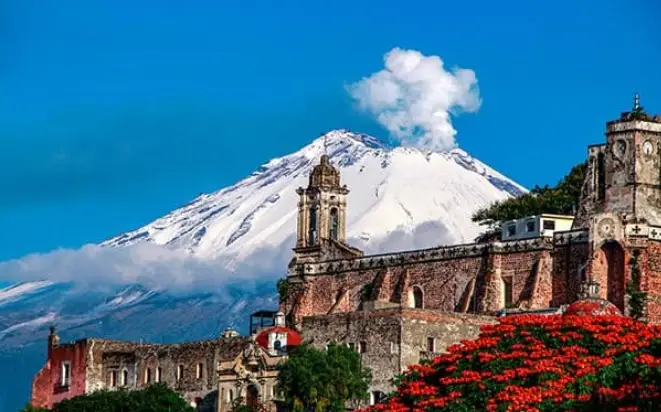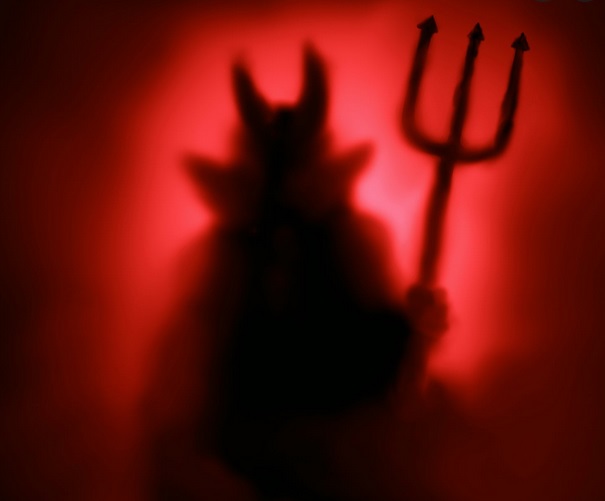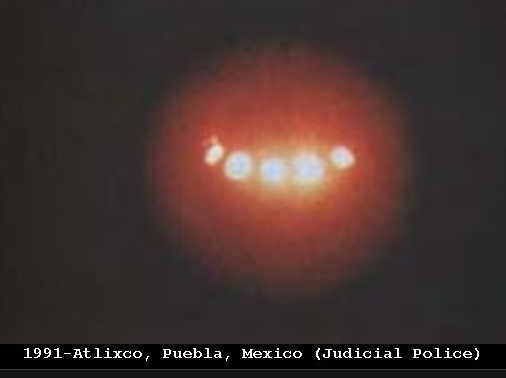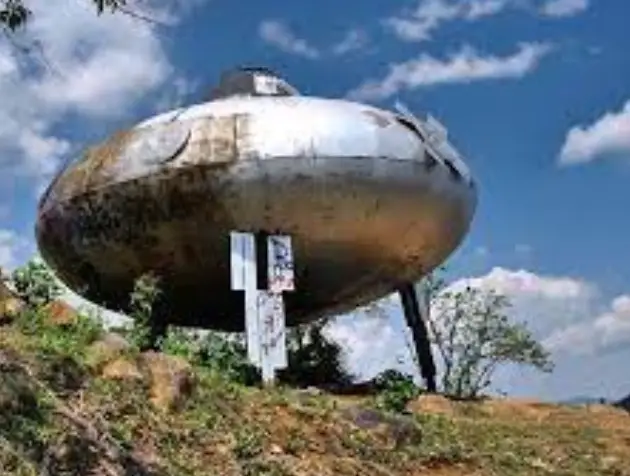Podcast: Play in new window | Download
Subscribe: Apple Podcasts | RSS
 Ariadna Ayala Camarillo welcomes visitors to her hometown of Atlixco with open arms and a warm smile. Before becoming mayor of this unusual place in the western part of the Mexican state of Puebla, Doctora Ayala was an accomplished trial attorney and an esteemed professor at the Meritorious Autonomous University of Puebla, known locally as BUAP. Although well-grounded by academics, law and family, Ayala recognizes privately that she is mayor of one of the most unusual towns in all Mexico, a place where paranormal activity and bizarre events have been occurring since the time before the Spanish Conquest.
Ariadna Ayala Camarillo welcomes visitors to her hometown of Atlixco with open arms and a warm smile. Before becoming mayor of this unusual place in the western part of the Mexican state of Puebla, Doctora Ayala was an accomplished trial attorney and an esteemed professor at the Meritorious Autonomous University of Puebla, known locally as BUAP. Although well-grounded by academics, law and family, Ayala recognizes privately that she is mayor of one of the most unusual towns in all Mexico, a place where paranormal activity and bizarre events have been occurring since the time before the Spanish Conquest.
Some modern-day locals openly acknowledge that Atlixco’s long history and the important role it played in the ancient civilizations of Mexico may contribute to its higher-than-average amount of “high strangeness.” The name “Atlixco,” although Nahuatl in origin, only dates to early colonial times, when a local indigenous settlement reorganized and then called itself by its modern name, which translates into English as “water in the valley” or “water on the earth’s surface.” Before the name Atlixco was given to this area, the settlement and surrounding lands was known as Cuauhquecollán, a name going back over a thousand years with origins in a small kingdom by that same name. The Kingdom of Cuauhquecollán was inhabited by a people called the Teochichimeca. Oral history at the time of the Spanish Conquest tells the story of the Teochichimeca coming into the valley where Atlixco now sits as raiders and killing off the indigenous group residing there to establish their new Kingdom of Cuauhquecollán. No one knows the name of the people there before the Teochichimeca arrived on the scene. The Teochichimeca were conquered by the Xicalanca from the southern Basin of Mexico and what is now the Mexican state of Tlaxcala. The Teochichimeca fought valiantly and lost many people before being absorbed into the new political state of the Xicalanca whose capital was Cacaxtla. While under Xicalanca control, Atlixco was also attacked by the small city-states of Huejotzingo and Calpan, and the larger kingdom of Cholula. For brief periods of time those three political entities took control of Atlixco. In the late 1400s, after several bloody battles, the area was eventually conquered by the Aztec Empire. The Aztecs regularly siphoned off captives from Atlixco to serve as slaves or sacrificial victims at their capital of Tenochtitlán. Local modern-day legend-tellers at Atlixco claim that the area is haunted by the spirits of thousands of warriors and civilian victims of war and conquest because of the hundreds or possibly thousands of years of intense indigenous fighting in the region. Some believe that Atlixco could be the site of some of the most bloodshed ever seen in Mexican prehistory.
 The Spanish may have had a good sense of the area’s history when they arrived. They decided to build monasteries and churches in the area to a higher degree than in other parts of New Spain. Officially, the Spanish established themselves in the area in the 1570s, a generation or two after the Aztec conquest. The Europeans moved in and immediately started reordering things. The indigenous name of one of the mountains overlooking the town has been lost to history, but the Spanish named it Cerro de San Miguel in honor of Saint Michael the Archangel, a religious figure always depicted slaying a demon. A small religious retreat was built atop the hill dedicated to Saint Michael supposedly in reaction to a bizarre event that happened here in the late 1500s. According to the legend – or local history – a group of indigenous elders got together to create a thought form to try to run off the Spanish. The object of their intention was none other than a double of the Devil himself. Spanish settlers reported seeing a red man with horns, a spiked tail and cloven feet, a classical rendition of the Prince of Darkness running around the valleys and hills around town. The settlers supposedly chased the creature to the top of the mountain where he fell into a well. Deep inside the well, the creature supposedly died, and the Spanish gave thanks to San Miguel Arcángel for causing the demon’s demise.
The Spanish may have had a good sense of the area’s history when they arrived. They decided to build monasteries and churches in the area to a higher degree than in other parts of New Spain. Officially, the Spanish established themselves in the area in the 1570s, a generation or two after the Aztec conquest. The Europeans moved in and immediately started reordering things. The indigenous name of one of the mountains overlooking the town has been lost to history, but the Spanish named it Cerro de San Miguel in honor of Saint Michael the Archangel, a religious figure always depicted slaying a demon. A small religious retreat was built atop the hill dedicated to Saint Michael supposedly in reaction to a bizarre event that happened here in the late 1500s. According to the legend – or local history – a group of indigenous elders got together to create a thought form to try to run off the Spanish. The object of their intention was none other than a double of the Devil himself. Spanish settlers reported seeing a red man with horns, a spiked tail and cloven feet, a classical rendition of the Prince of Darkness running around the valleys and hills around town. The settlers supposedly chased the creature to the top of the mountain where he fell into a well. Deep inside the well, the creature supposedly died, and the Spanish gave thanks to San Miguel Arcángel for causing the demon’s demise.
As an aside, the feast day of Saint Michael, also called Michaelmas on the Catholic calendar, is an important time for the town of Atlixco. Since the mid-1960s the traditional feast day of Saint Michael, September 29th, has incorporated more indigenous elements into it. These indigenous elements had been there for centuries but were either suppressed or celebrated off to the side. It was only in 1965 that the town of Atlixco officially proclaimed its first El Huey Atlixcayotl and added it to the festival of Saint Michael. El Huey Atlixcayotl is a Nahuatl phrases that loosely translates to “The Great Atlixco Tradition.” The townspeople kick off the festivities of El Huey Atlixcayotl on the last Saturday in September. The celebration is mostly a revival of a harvest festival to honor the ancient Mesoamerican god Quetzalcoatl. For more information about all things Quetzalcoatl, please see Mexico Unexplained episode number 100, “Quetzalcoatl: Man, Myth, God” : https://mexicounexplained.com/quetzalcoatl-man-myth-god/. In this newly revived indigenous festival, townsfolk and people from the surrounding area first elect a woman to fill the position of Xochicihuatl, which translates into English as “Flower Woman.” This festival queen presides over the main events that last a whole week, including a very unique dance called “Las Canastas” by locals. During Las Canastas, women dance with baskets of lit fireworks on their heads. Anthropologists believe this event has its roots in a female indigenous fire ritual that may date back a thousand years or more. The most important part of the Huey Atlixcayotl fiesta is the last Sunday of the event when the people of Atlixco join visitors from the surrounding areas to form a parade to the top of Cerro de San Miguel, the site of the famous devil incident. On the top of the mountain, alongside the mustard-colored chapel to San Miguel, there are music stands, food vendors and more dance performances. An annual tradition is to close off the event with the ritual Danza de los Voladores. The ritual consists of dance and the climbing of a pole almost 100 feet high from which four participants then launch themselves tied with ropes to descend to the ground in a swirling pattern around the pole. A fifth remains on top of the pole, dancing and playing a flute and drum. This danza is to ensure rains in the coming year, thus guaranteeing a good harvest. In 1996 government officials at the state level officially named the festival of El Huey Atlixcayotl as part of the Cultural Heritage of Puebla.
 Besides a deep and interesting indigenous past, Atlixco is home to various other things considered paranormal or “fringe.” One such curiosity is a stretch of road outside of town where strange gravitational anomalies are said to occur. Things are said to “roll uphill” and this includes everything from soccer balls to cars put in neutral. University-level researchers have surveyed the area and have declared that what appears to be a hill is actually a decline and that the terrain on the side of the road serves to create an optical illusion. True paranormal believers are not so quick to believe this scientific explanation and claim that this stretch of road is a place where “the veil is thin” between universes or physical realms. Some eyewitnesses have claimed to have seen strange creatures on the sides of this road. During the big phase of Chupacabra sightings across Mexico in the late 1990s, some claimed to have seen the creature here. For more information about this famous cryptid, please see Mexico Unexplained episode number 4: https://mexicounexplained.com/the-chupacabra/ While some have seen strange creatures or bizarre animals here, others have experienced periods of “missing time” when traveling this stretch of road at night along with the usual electrical problems with their cars occurring prior to the event.
Besides a deep and interesting indigenous past, Atlixco is home to various other things considered paranormal or “fringe.” One such curiosity is a stretch of road outside of town where strange gravitational anomalies are said to occur. Things are said to “roll uphill” and this includes everything from soccer balls to cars put in neutral. University-level researchers have surveyed the area and have declared that what appears to be a hill is actually a decline and that the terrain on the side of the road serves to create an optical illusion. True paranormal believers are not so quick to believe this scientific explanation and claim that this stretch of road is a place where “the veil is thin” between universes or physical realms. Some eyewitnesses have claimed to have seen strange creatures on the sides of this road. During the big phase of Chupacabra sightings across Mexico in the late 1990s, some claimed to have seen the creature here. For more information about this famous cryptid, please see Mexico Unexplained episode number 4: https://mexicounexplained.com/the-chupacabra/ While some have seen strange creatures or bizarre animals here, others have experienced periods of “missing time” when traveling this stretch of road at night along with the usual electrical problems with their cars occurring prior to the event.
In the mid-1990s Atlixco had another claim to fame. It was declared to be one of the top 7 UFO hotspots in the entire world. A great place for UFO viewing is at what locals call Punto Marconi, the top of a hill just outside of town. Punto Marconi offers sweeping vistas of the surrounding valleys as well as a direct and clear view of the Popocatépetl Volcano which has long been suspected by UFO researchers as being an extraterrestrial base. For more information about these claims, please see Mexico Unexplained episode number 84 titled, “Mexican Volcanoes, UFOs and Strange Humanoids,” https://mexicounexplained.com/mexican-volcanoes-ufos-strange-humanoids/ Not only have strange aerial craft been spotted coming out of or originating from the area of the volcano, other unusual objects have been spotted in the skies over the valleys surrounding Atlixco. These include everything from multicolored spheres, to orbs of light to traditional metallic flying  saucers. There was such enthusiasm from serious UFO researchers to rank amateurs at Punto Marconi that the leaders of Atlixco decided to mark the spot with public art that would eventually draw more tourists and curiosity seekers. They commissioned a metal sculptor from Chile named Ricardo Vivar to make a monument in the form of a gigantic UFO. The Autonomous University of Puebla donated an old water tank for the project, and the artist incorporated junkyard scraps and industrial waste to create a public art piece measuring almost 25 feet across and over 21 feet high. The sculpture’s formal name is “El OVNI de la Casita Blanca de Atlimeyaya,” or “The UFO of the Little White House of Atlimeyaya.” When the sculpture was finished in the year 2001 it was hailed as a modern masterpiece but in the years immediately following it failed to attract more people to Punto Marconi and the town of Atlixco. In fact, in the early 2000s, the UFO sightings, once plentiful in the mid-1990s, had dropped off and people stopped visiting the hill. Ricardo Vivar’s UFO sculpture is now rusting away on this obscure hill, with underbrush slowly overtaking it.
saucers. There was such enthusiasm from serious UFO researchers to rank amateurs at Punto Marconi that the leaders of Atlixco decided to mark the spot with public art that would eventually draw more tourists and curiosity seekers. They commissioned a metal sculptor from Chile named Ricardo Vivar to make a monument in the form of a gigantic UFO. The Autonomous University of Puebla donated an old water tank for the project, and the artist incorporated junkyard scraps and industrial waste to create a public art piece measuring almost 25 feet across and over 21 feet high. The sculpture’s formal name is “El OVNI de la Casita Blanca de Atlimeyaya,” or “The UFO of the Little White House of Atlimeyaya.” When the sculpture was finished in the year 2001 it was hailed as a modern masterpiece but in the years immediately following it failed to attract more people to Punto Marconi and the town of Atlixco. In fact, in the early 2000s, the UFO sightings, once plentiful in the mid-1990s, had dropped off and people stopped visiting the hill. Ricardo Vivar’s UFO sculpture is now rusting away on this obscure hill, with underbrush slowly overtaking it.
Besides the “high strangeness” at Atlixco, the town was declared a “Pueblo Mágico” or “Magical Town” by the Mexican government for its charm, history and deep traditions. Even for the non-paranormally-inclined, this beautiful corner of the Mexican state of Puebla is worth a visit.
REFERENCES
Various online sources, including the official Atlixco website (in Spanish): https://www.atlixco.gob.mx/
